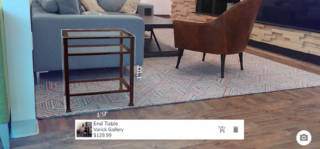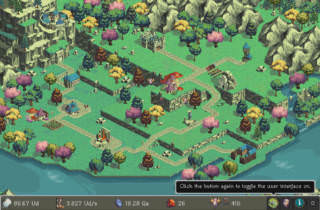Most people probably associate Wayfair with online furniture and home goods shopping—featuring brands such as AllModern, Birch Lane and Dwell Studio in addition to its own brand name items—but the company sees itself more as a tech brand that happens to sell furniture, similar to how Amazon happens to sell books.
That is why Wayfair launched the Wayfair Next team two years ago, headed by Mike Festa, to explore up-and-coming technologies such as augmented and virtual reality. It was one of the first companies to develop a commercial app for the Google Tango AR platform, which senses depth and motion in ways that ordinary smartphones cannot. Even though there are only two devices that support Tango right now (the newly launched Asus ZenFone AR and the Lenovo Phab 2) Wayfair sees AR as the future platform for online shopping.

Festa was a new engineer at Wayfair when he developed an AR app as a proof of concept at a hackathon. Not only did he win the hackathon, he was promoted to director of Wayfair Next, and his team has been working to integrate 3D models into the Wayfair app so that users can get their first taste of how AR enhances the online shopping experience.
The app detects whether or not a device supports Tango and will automatically enable its 3D shopping features accordingly. All users see is a new button for 3D shopping for certain items, which allows them to place computer rendered furniture items into their rooms to see how they look at scale. Users can freely move the virtual furniture around and rotate them as needed.
Festa sat down with AListDaily to discuss Wayfair’s AR app in detail and how the company believes the technology will shape the online shopping experience.
“We think AR is a great tool for customers to help visualize what they’re going to get before they buy it,” said Festa, discussing the company’s interest in the technology. “One of the challenges of selling home furnishings is figuring out how it will fit in people’s spaces. AR enables us to answer that question quickly and easily, as customers see how a product will fit with what they have.”
The standard Wayfair app lets users apply what Festa describes as “stickers” to their spaces. They’re 2D silhouettes of furniture items that users can zoom in and out on to imagine how they’d fit into their spaces.
“But people who have 3D Tango enabled phones get a 3D button, and that gives them content that helps them understand products better in their space,” said Festa. “It’s part of the shopping experience on mobile, and as more devices become capable of AR, more consumers will have access to that additional feature.”
That future might seem distant to some, given how Google Tango is only supported by two high-end mobile devices. However, Festa believes in the importance of true AR through Tango.
“I’ve been looking at a lot of different AR platforms that don’t use the Tango sensors, and I’ve found that Tango is incredibly stable and robust,” explained Festa. “That means we can put a piece of furniture into a space and have a high level of confidence that it will be to scale. If we put the real and digital products together side-by-side, they match every time we try it. Scale isn’t necessarily guaranteed with some of the other AR platforms, nor is the positioning. Sometimes, if you move a non-Tango device around, the product could be gone when you look back, or it’s floating up in the sky. Platform stability, scale and accuracy is what we’ve been getting out of Tango.”
But user adoption isn’t the only thing that Wayfair needs to consider. The bigger challenge is in getting more home goods manufacturers on board with AR, creating 3D content to promote their products.
 “We work with over 10,000 vendors to sell over eight million products, and we have about 40,000 3D-ready products right now,” said Festa. “We’re trying to work with vendors to create 3D models of their products. Since these are the early days of AR, most vendors don’t understand why they’d need to create a 3D model. So, with the emergence of the 3D platform, we’re going to get data to show whether a couch with a 3D model outsells one that doesn’t. If we can make that compelling case to suppliers, they’re going to create 3D content for us.”
“We work with over 10,000 vendors to sell over eight million products, and we have about 40,000 3D-ready products right now,” said Festa. “We’re trying to work with vendors to create 3D models of their products. Since these are the early days of AR, most vendors don’t understand why they’d need to create a 3D model. So, with the emergence of the 3D platform, we’re going to get data to show whether a couch with a 3D model outsells one that doesn’t. If we can make that compelling case to suppliers, they’re going to create 3D content for us.”
Festa also noted that, except for some high-end manufacturers, most furniture makers don’t design their products using CAD software. Most coffee tables are usually designed in shops, and changes to their design are done by making adjustments to a machine. But he hopes that, as more consumers have a chance to try AR shopping, more companies will warm up to the technology within a year or two.
“I think we’re one of the leading retailers to embrace this technology,” said Festa, talking about how the emphasis on technology helps Wayfair stand out from its competitors. “There are certainly others that are using 3D content in AR, but I don’t think any of them have the library of models and diversity of products that we do right now. But I’m also encouraged to see more competitors embrace the technology because that will help customers learn to expect it.
“Once customers use the experience, it becomes one of those things you get hooked on. The next time you buy something as big as furniture, if you don’t have an AR model or 3D preview, then you’re going to look for someone that offers that experience. That gives us an advantage right now, but I think that over time, AR is going to be a technology that consumers will pick up naturally, either by playing a game like Pokémon GO or shopping on Wayfair. App developers are going to create these new and interesting experiences and users will come to expect AR as part of the online shopping experience.”
So, considering how AR can significantly improve the shopping experience, why aren’t more of Wayfair’s competitors adopting the technology?
“It’s a big challenge, especially when creating the 3D content,” Festa replied. “When you think about the process of creating the content, putting it into an app and developing an app, it’s kind of risky. People haven’t necessarily embraced AR yet.
“I think by doing it early, Wayfair has an early-mover advantage and we’re actually a pretty big tech company. Although the Wayfair brand is well known, the Wayfair tech brand isn’t necessarily understood in the same way. Wayfair is in the space of being a furniture company, but we’re really a tech company with over a thousand engineers working on all kinds of interesting and complex problems—we just happen to sell furniture. AR is one of those interesting technologies we thought we could leverage for our business, and being a tech company, we took that on ourselves. Most other furniture companies would have to hire third-party contractors to do that because they don’t have the in-house capabilities. So, I see us as a tech company that’s looking to utilize the latest and greatest, which is why we made the leap into embracing AR when a lot of our competitors aren’t ready to do that.”
Wayfair has plans to improve on its AR app by allowing multiple products to be placed into a space, which was a feature in the original design until the company decided to simplify it to one item at a time. The company also has a number of decorative objects like coffee mugs that have been brought into its 3D library, but they’re mainly used in its developing VR application because “a VR room with only one piece of furniture looks really empty.”
Enhancements will depend entirely on how people are using the AR mobile app and what they want from it. “It’s just a matter of getting the right user experience,” said Festa. “We don’t want to overload people with too many features and buttons, but we’ll start introducing them if there’s demand for seeing those props in there.”
As for choosing the right technology to enhance the online shopping experience, Festa believes that there are more near-term opportunities with AR compared to VR, even though he’s a fan of both.
“VR is still a bit of an isolating technology, and people don’t understand it until they try it,” said Festa. “There’s a kind of social aspect to AR—where people can stand around a screen and look at something together—that VR doesn’t quite have yet. But I think that as devices become more connected, we’ll have shared experiences in VR that will be quite compelling. But AR is the main thing right now because it’s so easy to explain, show and share that experience with somebody.”





